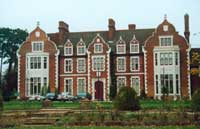
POLITICAL WARFARE EXECUTIVE

Towards his preparations for D Day, Delmer had been assigned an office on the top floor of Bush House, the department's new headquarters. Here he received with his female personal assistant all manner of shadowy callers, of all nationalities who were officers of the Underground Resistance groups, smuggled out of occupied Europe by S.O.E. and O.S.S. aircraft. As part of their briefing in England, for their role in the coming Invasion, they called on Delmer and in the course of their meeting he stressed the importance of giving the impression that there was a strong and growing German resistance movement. Courtesy of the department's very own black print section, many forged documents to help their members could be produced. This was then included in the canisters of arms and equipment that were parachuted by S.O.E. to the agents. Then, in anticipation of D Day, during 1943 and the relevant months of 1944, large numbers of political survey officers, later to be known as propaganda intelligence officers, underwent training at the local school, for their missions in the liberated countries and Germany. Having responsibility for their safe arrival overseas, S.O.E. would supply the P.W.E. material and also maintain subsequent communications. In fact two of the S.O.E. signal centres, linked by direct line to S.O.E. headquarters, were relatively local at Grendon Underwood and Poundon, coded 53A and 53B respectively. A station at Bicester, 53C, also operated from April until November, 1944, whilst the S.O.E. radio school, teaching operators to transmit morse at 25 words per minute, was situated at Thame.

P.W.E. commenced their planning for D Day in October, 1943, and on a vast scale the leaflet production began. Indeed, by March, 1944, 265 million leaflets, intended primarily for France and Germany, had been manufactured and dropped. For Lockhart, however, through a prolonged treatment for excema he suffered an enforced absence at this critical time, his first affliction having lasted from mid April until the end of June, 1943. Cared for at an Edinburgh nursing home, 9 Ettrick Road, the condition reoccurred in October and he underwent subsequent treatment at another nursing home in Edinburgh at 19, Great King Street. Returning to London in February, 1944, he then discovered his room at the club had been bombed out and his chauffeur, McCoy, took him to the Savoy, as an interim measure. Instructed to seek a house in the country, in the form of an old world cottage, near Radlett, Lockhart duly obliged but now under medical advice, he had little option but to lessen the responsibility duty. Since H.O. Lucas, the Deputy Director of Plans, had died soon after leaving P.W.E., the lack of senior staff became even more critical and Kirkpatrick was hurriedly appointed as an extra Deputy Director General. As the invasion of Europe approached, this proved a most opportune move.
Anglo American training.
Just before D Day, courses now began at the P.W.E. school near Woburn, for a small number of British and American officers, to include two weeks instruction in the theory of political warfare. They were to be dropped behind enemy lines and would then link up with the local resistance, helping to drive out the enemy and prepare a reception in the area, for the Allied forces.
Intelligence gathering
For their intelligence needs, P.W.E. had half a million documents filed by 1944 with the German material located in 8 main groups. 4 dealt with attitudes of the population, 3 with the attitude of the armed forces and the 8th, with everything else, divided into 34 sub divisions. Also of great assistance, in the intelligence gathering, the Monitoring Service of the B.B.C. constantly listened to some 32 languages and supplied both P.W.E. and the B.B.C. with valuable information. The operation had risen from humble beginnings to become a vast organisation, as indeed had the B.B.C. and in fact in '1984', George Orwell based the Ministry of Truth on his observation of the B.B.C., during World War Two. By March, 1944, their employees totalled 11,663, dealing with 43 foreign language services.